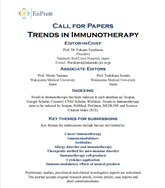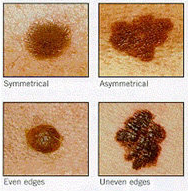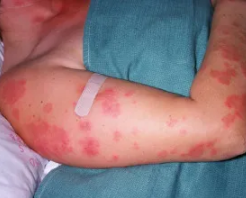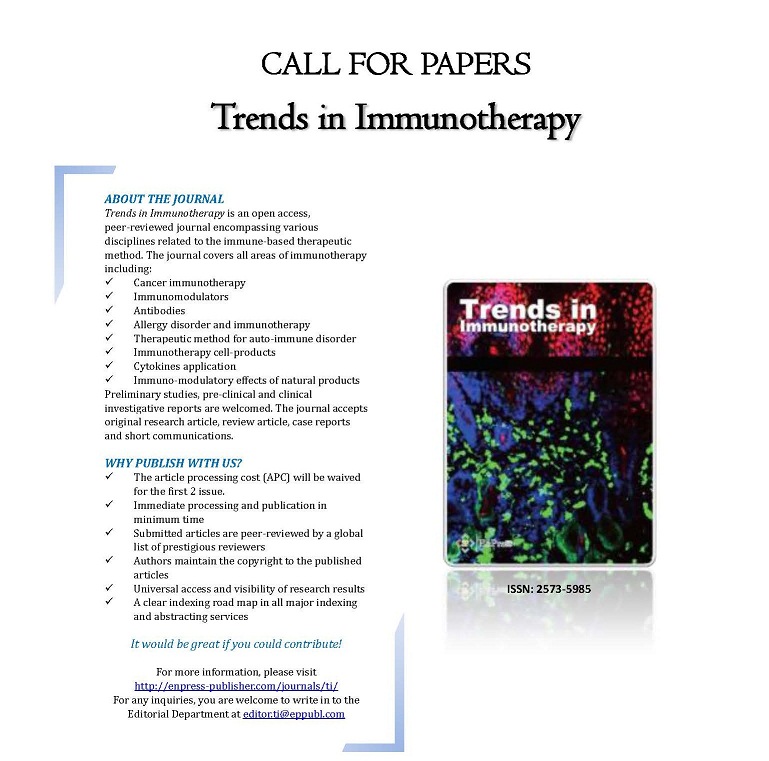New Author Guidelines are updated |
|
Please follow the journal's author guideline and the required article template to prepare your manuscript. |
|
| Posted: 2023-09-06 | More... |
PROF. ZHILING YU APPOINTED AS CO-EDITOR-IN-CHIEF OF TRENDS IN IMMUNOTHERAPY |
|
Prof. Zhiling Yu School of Chinese Medicne at Hong Kong Baptist University. Vice Chairperson of Special Committee of Immunology of TCM of World Federation of Chinese Medicine Societies. Council Member of Hong Kong Society for Immunology, China Interests: Pharmacology of anti-inflammatory and anticancer Chinese medicines
|
|
| Posted: 2023-03-30 | More... |
Perspective on allergen immunotherapy |
|
| In recent years, there have been attempts to improve the safety and convenience for patients whilst retaining efficacy of allergen immunotherapy. These include the use of modified allergens (known as allergoids) and alternative routes of immunotherapy. | |
| Posted: 2022-10-29 | More... |
SITC 2022 will be held in November |
|
 |
|
| Posted: 2022-08-16 | More... |
About the awarding of Master of Dermatology |
|
| Congratulations! Fukumi Furukawa, MD, PhD, Editor-in-chief of Trends in Immunotherapy (TI), was selected as the winner of the Master of Dermatology in 2022. | |
| Posted: 2022-05-18 | More... |
Revision of Article Processing Charges |
|
Starting June 1, 2022, Trends in Immunotherapy (TI) will incur an Article Processing Charge (APC) of US$ 1,000. |
|
| Posted: 2022-05-09 | More... |
Trends in Immunotherapy has been indexed by Scopus! |
|
 |
|
| Posted: 2022-01-10 | More... |
Call for papers for Volume 5, 2021 |
|
|
|
| Posted: 2021-08-26 | More... |
COVID-19 natural immunity |
|
 |
|
| Posted: 2021-08-09 | More... |
Call for papers for Special Issue: Volume 5 Issue 2.1, 2021 |
|
Special Issue Theme Topic: Research Progress in Immunotherapy in China Issue: Volume 5 Issue 2.1, 2021 Key themes for submissions include but are not limited to: 1. Cancer immunotherapy 2. Targeted therapy and tumor microenvironment 3. Immune dysregulation, skin barrier dysfunction 4. Chemoimmunotherapy 5. Antibodies 6. Immunomodulators, inhibitors and intensifiers 7. Therapeutic method for auto-immune disorder 8. Efficacy of drug immunotherapy 9. Allergy disorder and immunotherapy 10. Immunotherapy cell-products 11. Immuno-modulatory effects of natural products 12. Vaccine development and application 13. Cytokines application 14. Wound healing TI publishes original research articles, review articles, editorials, mini-review articles, case reports, commentaries, correspondence articles, database articles, perspective articles, short reports, etc. Preliminary studies, pre-clinical and clinical investigative reports are welcomed. |
|
| Posted: 2021-06-16 | More... |
How does melanoma come into being? |
|
Most moles are not dangerous, but melanoma may look like moles, and some may develop from moles. If ultraviolet radiation is excessive, usually through long-term exposure over a lifetime, melanocytes may begin to grow uncontrolled. If there is indeed excessive radiation, melanocytes will become melanoma, usually in people with a genetic predisposition to this condition. Melanoma has the tendency to invade nearby tissues and then spread to the whole body through the blood or lymphatic system.
|
|
| Posted: 2021-05-12 | More... |
Cutaneous lupus erythematosus? Effective medicine? |
|
What is cutaneous lupus erythematosus? Cutaneous lupus erythematosus is an immune disease that damages the skin and leads to the emergence of some antibodies. It mostly occurs in women of childbearing age, and may also occur in children and the elderly. Comprehensive factors such as heredity, infection, environment, sex hormones and drugs can lead to immune disorder and the occurrence of the disease. Most of the lesions of skin and mucous membrane can appear various rashes. The mild ones are slightly edematous erythema, and the severe ones can appear blisters, ulcers, erosion, skin atrophy and pigmentation. Butterfly erythema is a skin and mucous membrane manifestation with diagnostic specificity. Arthritis or joint swelling and pain, keratitis may also occur. Due to genetic and environmental factors, patients have lost immune tolerance, resulting in the production of antinuclear antibodies.
|
|
| Posted: 2021-04-20 | More... |
PPAR-β/δ plays a vital physiological role by regulating inflammation,cell proliferation, and differentiation |
|
| Peroxisome proliferator-activated receptor β/δ (PPAR-β/δ) is a ligand-activated transcription factor of the PPAR nuclear receptor family that plays important roles in the regulation of cellular metabolism by binding to sequence-specific DNA elements . PPAR-β/δ plays a vital physiological role by regulating inflammation, energy homeostasis, cell proliferation, and differentiation . Besides its expression in peripheral organs, PPAR-β/δ is also highly expressed in the central nervous system . | |
| Posted: 2020-12-15 | More... |
How to deal cutaneous toxicities to EGFR inhibitors? |
|
| Recent studies have shown that the epidermal growth factor receptor (EGFR) plays a critical role in cancer development and progression, including cell proliferation, apoptosis, angiogenesis, and metastatic spread. | |
| Posted: 2020-11-18 | More... |
Emerging roles of PPARS in inflammation and immunity |
|
| Peroxisome proliferator-activated receptors (PPARs) are members of the nuclear receptor family. After activation by specific ligands, they regulate the transcription of genes involved in lipid and lipoprotein metabolism, glucose and energy homeostasis,as well as cellular differentiation. Most studies have identified expression of the three PPARs in all cells of the arterial wall, where they control cholesterol homeostasis as well as the inflammatory response and, as a consequence, modulate atherogenesis. More generally, PPARs influence cell proliferation as well as the immune and inflammatory response in different tissues and cells. | |
| Posted: 2020-10-28 | More... |
Salmonella has become a serious threat,we need to access vaccines more effectiveness |
|
| Salmonella is a Gram-negative facultative rod-shaped bacterium in the same proteobacterial family as Escherichia coli, the family Enterobacteriaceae, trivially known as "enteric" bacteria. Salmonella is nearly as well-studied as E. coli from a structural, biochemical and molecular point of view, and as poorly understood as E. coli from an ecological point of view. Salmonellae live in the intestinal tracts of warm and cold blooded animals. Some species are ubiquitous. Other species are specifically adapted to a particular host. In humans, Salmonella are the cause of two diseases called salmonellosis: enteric fever (typhoid), resulting from bacterial invasion of the bloodstream, and acute gastroenteritis, resulting from a foodborne infection/intoxication.At the beginning of the 19th century, typhoid was defined on the basis of clinical signs and symptoms and pathological (anatomical) changes. However, at this time, all sorts of enteric fevers were characterized as "typhoid". | |
| Posted: 2020-09-01 | More... |
How to treat alopecia areata,Immunotherapy may be a good choice |
|
| Alopecia areata (AA) usually manifests as patches of non-scarring hair loss due to immune dysregulation.However, more severe forms may affect the entire scalp (alopecia totalis: AT) or body hair including eyebrows, cilia, axillary hair and hair of the pubis (alopecia universalis: AU). | |
| Posted: 2020-04-28 | More... |
Citrus jabara can reduce allergic diseases and inflammationcan reduce allergic diseases and inflammation |
|
Citrus jabara is a cultivar of citrus native to Kitayama village in Wakayama prefecture, Japan.Jabara has gained much attention in recent years for its effect on alleviating seasonal allergy symptoms . Jabara has been found to be particularly rich in the dietary flavonoid narirutin (naringenin-7-O-β-D-rutinoside) commonly found in citrus that is reported to possess anti-allergic property. The anti-allergic property of narirutin has been shown in both in vitro and in vivo studies using a mouse model of atopic dermatitis and airway inflammation. |
|
| Posted: 2020-04-20 | More... |
Volume 2, Issue 2, 2018 is now live! |
|
| The full issue of Volume 2, Issue 2, 2018 is now available online at here! | |
| Posted: 2018-07-01 | |
Volume 2, Issue 1, 2018 is now live! |
|
| The full issue of Volume 2, Issue 1, 2018 is now available online at here! | |
| Posted: 2018-03-30 | |
Volume 1, Issue 3, November 2017 is now live! |
|
| The full issue of Volume 1, Issue 3, November 2017 is now available online at here! | |
| Posted: 2017-11-27 | |
Trends in Immunotherapy Volume 1, Issue 2, August 2017 is now published online! |
|
The full issue of Volume 1, Issue 2, August 2017 is now available online at here! |
|
| Posted: 2017-08-29 | |
The inaugural issue of Trends in Immunotherapy is now live! |
|
We are pleased to announce that the inaugural issue of Trends in Immunotherapy (Volume 1, Issue 1, May 2017) has been officially published. The full issue is currently available for download at here. |
|
| Posted: 2017-05-29 | |
Call for Papers |
|
Enpress Publisher LLC. and the Chief Editor of Trends in Immunotherapy, Prof. Fukumi Furukawa, invite all authors to submit manuscripts for peer-review.
|
|
| Posted: 2017-03-06 | More... |
| 1 - 24 of 24 Items | |















